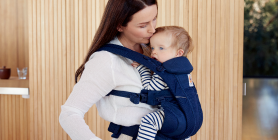- Home
- Blog
September 28, 2012
At 37 weeks, I’m considered full term. This means that even though I’m not due until October, my baby could come any day now and be considered “on time.” In my opinion (as a first time momma), this is equally exciting and terrifying. However, in the last week, I have scrambled to prepare myself for what’s to come and surprisingly found peace with the whole process. Here are a few things I wish I’d known from the very beginning that probably would have brought that peace on much sooner!
Don’t wing it. This is one of my biggest regrets and quite possibly the reason I felt the need to blog. When I found out I was pregnant, I instantly felt the urge to buy tiny little items, but failed to buy any books, sign up for classes or do much of anything to prepare myself mentally for labor and delivery. I looked at it in a very primal way - women didn’t have the internet, classes and books to prepare them before, so why should I have them? While I’m still pretty sure my body will go into an animalistic
August 29, 2012
When I got engaged, it seemed everyone felt the need to share their opinions on how to be a wife. While it sometimes made me feel as if I had no idea what I was doing, in all actuality, not one of the unsolicited advice donors knew my husband or what he wanted in a wife more than I do.
Now that I’m pregnant, it seems like I’m having deja vu. Only at 33 weeks, my unborn child has become much more obvious than an engagement ring, meaning even strangers feel the need to offer their advice. While I try to keep my cool, it gets old hearing that I should give up my vegan lifestyle and shouldn’t teach my child why we live the lifestyle that we do. That being said, here are 5 tips I’ve found to help prevent a pregnancy rage blackout on someone I don’t know well enough to experience that moment with:
Keep in mind that they mean well. I recently went through a long lecture against teaching my chid why we’re vegan from an acquaintance that just so happens to be one of the nicest people I know. Everything
August 28, 2012
Editor's note: Written from the point of view of the Ergobaby Original Carrier - Black/Green, a retired color:
Hi there. I know this is not your typical blog post, but I heard that Ergobaby wanted to hear some great travel stories…and boy, have I got a ton to tell you! You see, I’ve been around the block a few times after being given to a wonderful family. I’m an Ergobaby Original Carrier - Black/Green. They don’t even make my color anymore, that’s how long I’ve been around. Before I met my family, I sat in a warehouse with all of the other Ergobaby Carriers wondering what type of family I’d be going to – and I was thrilled to be pulled off the shelf one day and my journey started in a nice brown cardboard box.
When I arrived at my final destination, central Maryland, I was shocked to find out that my family hadn’t even originally wanted me! The mom was pregnant and had a big ol’ belly, and the dad was into all sorts of outdoor things. I found out that, at first, they had put a DIFFERENT
August 24, 2012
I feel very blessed to have nursed all three of my children for varying lengths, but it is since my youngest has stopped nursing that I see something new and special... something unexpected in the bond beyond breastfeeding. Gwyneth nursed for about 27 months and when she stopped nursing my breasts were not automatically "mine" again, much to my surprise. With my first two children they just sort of moved onto something else - case closed so to speak. Some 9 months now after breastfeeding, Gwenny still claims my breasts as her own and she will fight me if I say that they are mine. She still prefers to fall asleep with her hand on my chest, and if she catches Daddy looking at them she will sometimes cover me up with my blanket and tell me that she is protecting me (or them?). I find it all comical and we play and laugh, but more than anything I am touched by the notion that my body is still her comfort. Though I am no longer providing her physical nourishment, I am still giving her emotional
August 24, 2012
I love walking my dogs with my baby. We all get out of the house, get some fresh air, and spend some time together. However, when you have a dog, other people with dogs often like to stop to say hi. You might also want to take your dog to a dog park where they can play off leash and socialize with their doggy friends. Doing this with a stroller would be pretty much impossible, whereas wearing your baby in a carrier frees up your hands and gives you a lot more flexibility in terms of the terrain you can tackle. The question, then, is which carrier to use. From my perspective as a behavior analyst, dog trainer, dog owner, and mom to two young sons, I have developed a strong preference for the Ergo, and recommend it to all my clients with babies. Here is why. (Please note that I am not in any way associated with the Ergobaby company; they did not ask me to write this or offer me products– it is entirely my own opinion.)
Many of the dogs we know and love are, well, a little nutty. One of my
August 16, 2012
When I was a first time mom, I got a lot of advice. I even got advice about people's advice! Now that I've been through three years of motherhood and have just become a new mom again, I suppose I've earned my turn to give some advice. Take what speaks to you, and leave the rest, but most importantly, enjoy the journey!
Take the first 2 weeks and lay in bed with baby. Have other people in place to do everything else that needs done. Freeze some meals ahead of time so you don't have to worry about food (and have full instructions on each meal so you don't have to look that up and anyone will be able to just follow the instructions.)
It's okay if baby sleeps in bed with you. It's okay if baby sleeps in a crib. The key is that mama and baby are both getting some sleep. I found it a lot easier for me to get sleep and for baby to sleep happily (read: not wake up crying in the night) if we shared a bed and it was a lot easier to nurse her as well. But your baby may be different.
August 12, 2012
After a week of sunshine and warm weather this past July, the typical gray skies of Western Washington returned, along with 60 degree temperatures. It turns out though that 60 degrees and gray skies is perfect weather for blueberry picking! My summer bucket list just received another check mark. Bergen and I met Nina and her two kids (ages 1 & nearly 5) at Larsen Lake in Bellevue, Washington, a suburb of Seattle, to see just how many blueberries we could gather in our buckets. We both strapped the babies into their ergos on our backs, and with Maya in the lead we started down the main path. Hundreds of blueberry bushes line this greenbelt area in the middle of suburbia allowing us to have our choice of spots to start from. As we started picking away, Maya and I took Nina's advice:
Pay attention to the color of the berry. The darker the better. If the blueberry isn't blue, it's not ready to be picked!
If the berry just seems to fall right off the stem, it's probably a good choice!
August 11, 2012
Babywearing is a topic that comes up when I go on interviews with potential clients. It is a topic that came up when I first met Lindsay Price from 90210 and Lipstick Jungle fame. I assured her that I would help her get established with babywearing if she decided to have me as her postpartum doula. Mutually, we agreed that we were a good match and the day Lindsay brought her newborn son, Hudson, home from the hospital, I was there to support her in her new role as a mother. I encourage babywearing from early newborn days to toddlerhood and beyond if possible. The benefits to both parents and babies are priceless. Early babywearing is beneficial to foster bonding between parent and baby. Hugging baby close in a carrier is a wonderful way to get to know your baby and for your baby to learn about you. Babies also thrive with touch, and babywearing is a wonderful way to maintain a loving contact with your baby. Beyond bonding and touch, babies who are worn are more
August 10, 2012
It was just about five months ago now that my husband and I stood peering at two very positive lines on a pregnancy test. Our thirteen month old daughter; oblivious to our fast changing life, was sleeping soundly down the hall. Unreal is the only word that could describe that moment; coming to grips with the fact that we would have two children, under the age of two in the very near future. Of course, once the shock wore off, we were thrilled beyond words. A brand new adventure was about to wrap us up into an exciting, fresh chapter in our lives. Fast forward a few months into my pregnancy. I woke up with a sense of excitement; I was to see our sweet baby on a ultrasound screen this day at my OB/GYN appointment. My daughter woke up, and I hurried around our home, getting little one and myself ready to walk out the door. Already, I was a little flustered; feeling a likeness to a pack mule as I tried climbing the stairs with a twenty four pound toddler on my hip,
August 09, 2012
I think one of the biggest gifts we can give our kids is the gift of travel. Not only does travel expose children to amazing locations, but also it teaches about other cultures, develops situational flexibility, encourages imaginative thinking, and helps illustrate a sense of world scale.
When my first son, Alexander, was only 5 months old, we had the amazing opportunity to pack our bags (and our house!) and head to England for 3 years. While some might find the thought terrifying, we were so excited about the opportunities it was going to give us to go, do, and see!
While in England, our family grew with the birth of our second son, Edward. But even with a toddler and a newborn, we took every travel opportunity we could (the Ergobaby Carrier sure did help!!).
Our first holiday as a family of four was to England’s famous Lake District. We found a nice holiday cottage to rent just outside of the town of Keswick. Weather in England can be quite unpredictable, but the Weather Gods must have
























